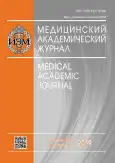ИНТЕГРАЛЬНЫЙ АДАПТИВНЫЙ ОТВЕТ ОРГАНИЗМА ПРИ ВОЗДЕЙСТВИЯХ ШИРОКОДИАПАЗОННЫМ СТОХАСТИЧЕСКИ ОРГАНИЗОВАННЫМ ЭЛЕКТРОМАГНИТНЫМ ИЗЛУЧЕНИЕМ НА ЛОКАЛИЗОВАННЫЙ ПРОЦЕСС ФОРМАЛИНОВОГО ОТЕКА, ИНДУЦИРУЮЩЕГО НЕЙРОГЕННУЮ БОЛЬ
- Авторы: Шихлярова АИ1, Жукова ГВ1, Гончарова АС1, Брагина МИ1, Жадобина АА1, Протасова ТП1, Лукбанова ЕА1
-
Учреждения:
- ФГБУ «Ростовский научно-исследовательский онкологический институт» Минздрава России
- Выпуск: Том 19, № 1S (2019)
- Страницы: 151-152
- Раздел: Статьи
- Статья опубликована: 15.12.2019
- URL: https://journals.eco-vector.com/MAJ/article/view/19374
- ID: 19374
Цитировать
Полный текст
Аннотация
Полный текст
Об авторах
А И Шихлярова
ФГБУ «Ростовский научно-исследовательский онкологический институт» Минздрава России
Г В Жукова
ФГБУ «Ростовский научно-исследовательский онкологический институт» Минздрава России
А С Гончарова
ФГБУ «Ростовский научно-исследовательский онкологический институт» Минздрава России
М И Брагина
ФГБУ «Ростовский научно-исследовательский онкологический институт» Минздрава России
А А Жадобина
ФГБУ «Ростовский научно-исследовательский онкологический институт» Минздрава России
Т П Протасова
ФГБУ «Ростовский научно-исследовательский онкологический институт» Минздрава России
Е А Лукбанова
ФГБУ «Ростовский научно-исследовательский онкологический институт» Минздрава России
Список литературы
- Garkavi LKh, Kvakina EB, Kuzmenko TS, Shikhlyarova AI. Anti-stress reactions and activation therapy. Ekaterinburg; 2002. Part I 196 p., Part II 238 p. (In Russ.)
- Orlov VI, Rudenko MY, Shikhlyarova AI, et al. Mechanisms of electromagnetic influences and effects on membrane systems in neurons and cardiomyocytes. Cardiometry. 2017;11:17-27.
- Selye H. The evolution of the stress concept. Am. Scientist. 1973;62(6):642-649.
Дополнительные файлы







